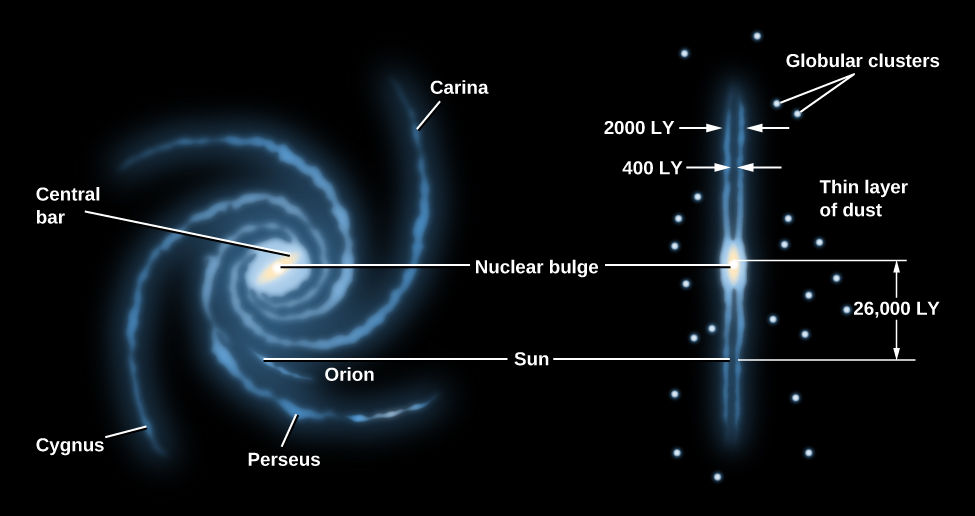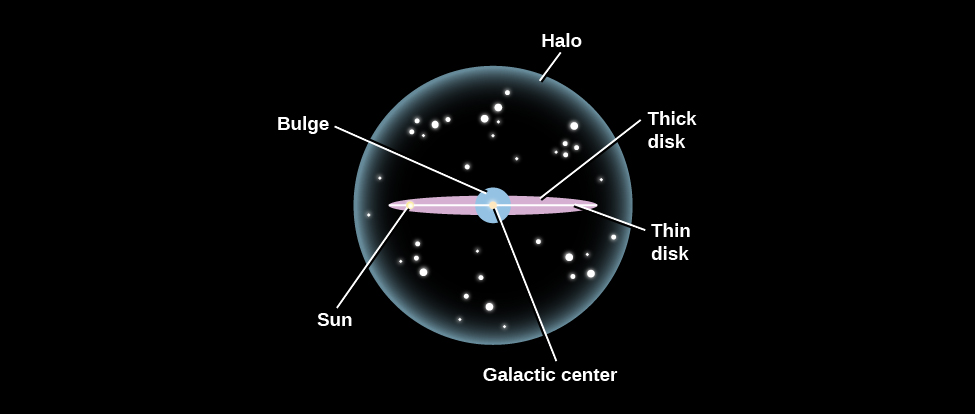12.1 The Milky Way Galaxy
Milky Way Galaxy

The Milky Way above Hovenweep Castle by NPS/Jacob W. Frank, Public Domain
Today, we know that our Sun is just one of the many billions of stars that make up the huge cosmic island we call the Milky Way Galaxy. How can we “weigh” such an enormous system of stars and measure its total mass?
One of the most striking features you can see in a truly dark sky—one without light pollution—is the band of faint white light called the Milky Way, which stretches from one horizon to the other. The name comes from an ancient Greek legend that compared its faint white splash of light to a stream of spilled milk. But folktales differ from culture to culture: one East African tribe thought of the hazy band as the smoke of ancient campfires, several Native American stories tell of a path across the sky traveled by sacred animals, and in Siberia, the diffuse arc was known as the seam of the tent of the sky.
In 1610, Galileo made the first telescopic survey of the Milky Way and discovered that it is composed of a multitude of individual stars. Today, we know that the Milky Way comprises our view inward of the huge cosmic pinwheel that we call the Milky Way Galaxy and that is our home. Moreover, our Galaxy is now recognized as just one galaxy among many billions of other galaxies in the cosmos.
The Milky Way Galaxy surrounds us, and you might think it is easy to study because it is so close. However, the very fact that we are embedded within it presents a difficult challenge. Suppose you were given the task of mapping New York City. You could do a much better job from a helicopter flying over the city than you could if you were standing in Times Square. Similarly, it would be easier to map our Galaxy if we could only get a little way outside it, but instead we are trapped inside and way out in its suburbs—far from the galactic equivalent of Times Square.
With modern instruments, astronomers can now penetrate the “smog” of the Milky Way by studying radio and infrared emissions from distant parts of the Galaxy. Measurements at these wavelengths (as well as observations of other galaxies like ours) have given us a good idea of what the Milky Way would look like if we could observe it from a distance.
Figure 12.2 sketches what we would see if we could view the Galaxy face-on and edge-on. The brightest part of the Galaxy consists of a thin, circular, rotating disk of stars distributed across a region about 100,000 light-years in diameter and about 1000 light-years thick. (Given how thin the disk is, perhaps a CD is a more appropriate analogy than a wheel.) In addition to stars, the dust and gas from which stars form are also found mostly in the thin disk of the Galaxy. The mass of the interstellar matter is about 15% of the mass of the stars in this disk.
As the diagram in Figure 12.2 shows, the stars, gas, and dust are not spread evenly throughout the disk but are concentrated into a central bar and a series of spiral arms. Recent infrared observations have confirmed that the central bar is composed mostly of old yellow-red stars. The two main spiral arms appear to connect with the ends of the bar. They are highlighted by the blue light from young hot stars. We know many other spiral galaxies that also have bar-shaped concentrations of stars in their central regions; for that reason they are called barred spirals. Figure 12.3 shows two other galaxies—one without a bar and one with a strong bar—to give you a basis for comparison to our own. We will describe our spiral structure in more detail shortly. The Sun is located about halfway between the centre of the Galaxy and the edge of the disk and only about 70 light-years above its central plane.
Unbarred and Barred Spiral Galaxies
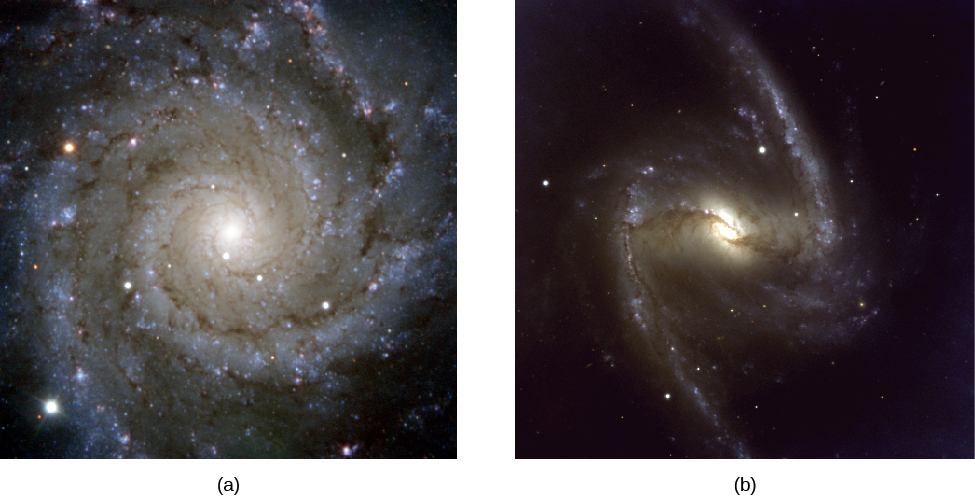
Credit a: PESSTO snaps Supernova in Messier 74 by ESO/PESSTO/S. Smartt, CC-BY-4.0.
Credit b: Fine Details in a Barred Galaxy by ESO, CC BY-4.0.
Our thin disk of young stars, gas, and dust is embedded in a thicker but more diffuse disk of older stars; this thicker disk extends about 3000 light-years above and below the midplane of the thin disk and contains only about 5% as much mass as the thin disk.
Close in to the galactic centre (within about 10,000 light-years), the stars are no longer confined to the disk but form a central bulge (or nuclear bulge). When we observe with visible light, we can glimpse the stars in the bulge only in those rare directions where there happens to be relatively little interstellar dust. The first picture that actually succeeded in showing the bulge as a whole was taken at infrared wavelengths as shown in Figure 12.4.
Inner Part of the Milky Way Galaxy

Two Micron All Sky Survey by NASA/2MASS, NASA Media License.
The fact that much of the bulge is obscured by dust makes its shape difficult to determine. For a long time, astronomers assumed it was spherical. However, infrared images and other data indicate that the bulge is about two times longer than it is wide, and shaped rather like a peanut. The relationship between this elongated inner bulge and the larger bar of stars remains uncertain. At the very centre of the nuclear bulge is a tremendous concentration of matter, which we will discuss later in this chapter.
In our Galaxy, the thin and thick disks and the nuclear bulge are embedded in a spherical halo of very old, faint stars that extends to a distance of at least 150,000 light-years from the galactic centre. Most of the globular clusters are also found in this halo.
The mass in the Milky Way extends even farther out, well beyond the boundary of the luminous stars to a distance of at least 200,000 light-years from the centre of the Galaxy. This invisible mass has been give the name dark matter because it emits no light and cannot be seen with any telescope. Its composition is unknown, and it can be detected only because of its gravitational effects on the motions of luminous matter that we can see. We know that this extensive dark matter halo exists because of its effects on the orbits of distant star clusters and other dwarf galaxies that are associated with the Galaxy.
Some vital statistics of the thin and thick disks and the stellar halo are given in Table 12.1, with an illustration in Figure 12.5. Note particularly how the ages of stars correlate with where they are found. As we shall see, this information holds important clues to how the Milky Way Galaxy formed.
| Property | Thin Disk | Thick Disk | Stellar Halo (Excludes Dark Matter) |
|---|---|---|---|
| Stellar mass | 4 × 1010MSun | A few percent of the thin disk mass | 1010MSun |
| Luminosity | 3 × 1010LSun | A few percent of the thin disk luminosity | 8 × 108LSun |
| Typical age of stars | 1 million to 10 billion years | 11 billion years | 13 billion years |
| Heavier-element abundance | High | Intermediate | Very low |
| Rotation | High | Intermediate | Very low |
Establishing this overall picture of the Galaxy from our dust-shrouded viewpoint inside the thin disk has been one of the great achievements of modern astronomy (and one that took decades of effort by astronomers working with a wide range of telescopes). One thing that helped enormously was the discovery that our Galaxy is not unique in its characteristics. There are many other flat, spiral-shaped islands of stars, gas, and dust in the universe. For example, the Milky Way somewhat resembles the Andromeda galaxy, which, at a distance of about 2.3 million light-years, is our nearest neighbouring giant spiral galaxy. Just as you can get a much better picture of yourself if someone else takes the photo from a distance away, pictures and other diagnostic observations of nearby galaxies that resemble ours have been vital to our understanding of the properties of the Milky Way.
Our radio observations of the disk’s gaseous component indicate that the Galaxy has two major spiral arms that emerge from the bar and several fainter arms and shorter spurs. You can see a recently assembled map of our Galaxy’s arm structure—derived from studies in the infrared—in Figure 12.6.
Milky Way Bar and Arms
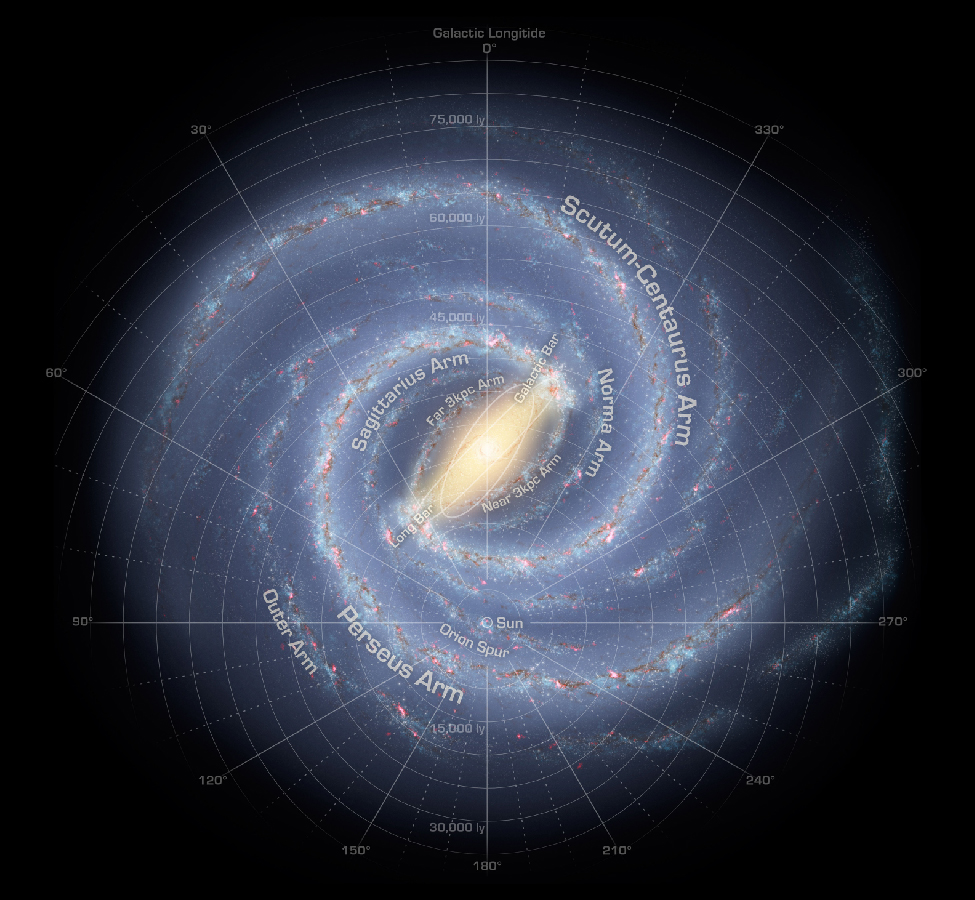
The Milky Way Galaxy by NASA/JPL-Caltech/R. Hurt (SSC/Caltech), NASA Media License.
The Sun is near the inner edge of a short arm called the Orion Spur, which is about 10,000 light-years long and contains such conspicuous features as the Cygnus Rift (the great dark nebula in the summer Milky Way) and the bright Orion Nebula. Figure 12.7 shows a few other objects that share this small section of the Galaxy with us and are easy to see. Remember, the farther away we try to look from our own arm, the more the dust in the Galaxy builds up and makes it hard to see with visible light.
Orion Spur
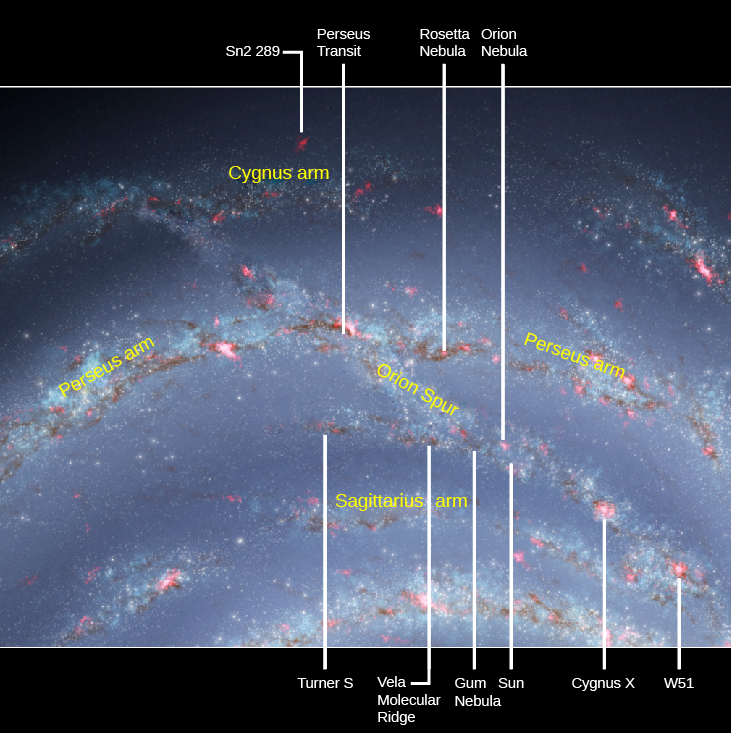
Modification of The Milky Way by NASA/JPL-Caltech, NASA Media License.
Attribution
“25.0 Thinking Ahead“, “25.1 The Architecture of the Galaxy“, and “25.2 Spiral Structure” from Douglas College Astronomy 1105 by Douglas College Department of Physics and Astronomy, is licensed under a Creative Commons Attribution 4.0 International License, except where otherwise noted. Adapted from Astronomy 2e.

